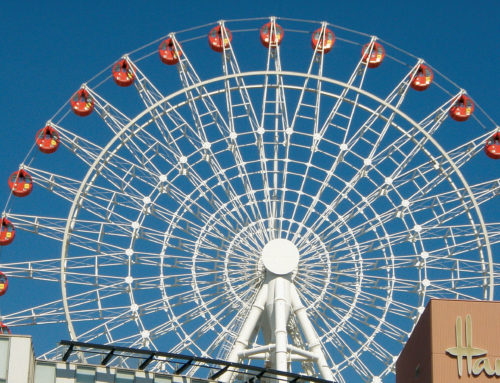
Nicholas DeMaison
Composer, conductor, senior arts lecturer
The Conductor’s Suite in the Curtis R. Priem Experimental Media and Performing Arts Center (EMPAC) has (for my money) one of the best views of downtown Troy to be found from the Rensselaer campus, particularly in autumn. Perched over 8th Street, the front windows of EMPAC point directly (perhaps intentionally so?) at the maroon vaulted roof of the Troy Savings Bank Music Hall (133 years EMPAC’s senior) not even half a mile away at the corner of 2nd and State streets. In the same visual frame, lined by the trees along 8th Street, are the blue-gray tower of St. Paul’s (famous for its Tiffany interior) within a cluster of stone and white spires, the arching windows and oddly square bell tower of the Rensselaer County Courthouse, and next to it, the Troy Public Library (whose stacks sit on a series of translucent glass floors), the rows of Victorian brownstones of Troy, and beyond the grid of buildings, the leafy hillside sloping west from the Hudson, the foliage emerging from the mottled historic brick of the city.
The Conductor’s Suite is named for Joel Dolven, Rensselaer’s enormously influential kappelmeister (so to speak) from the late 1940s until 1970. Joel directed the Glee Club and the Orchestra, conducted musicals at the RPI Playhouse, and led an annual holiday Campus Carols candlelight concert (now the President’s Annual Holiday Concert, held at EMPAC). There is a picture of Joel on the wall of the suite, leading the Orchestra in what appears to be one of these candlelight concerts. The first time I saw the photo, I did not realize that Joel was my predecessor at Rensselaer, two generations earlier.
Joel missed out on performing at EMPAC by quite some margin. Instead, ensembles in his era performed in just about every other conceivable space on campus large enough to hold a performance (the gymnasium, the Field House, the Playhouse), as well as at the Troy Savings Bank Music Hall. And, on October 21, 1950, the Glee Club made a brief appearance at New York’s Carnegie Hall. How fitting, then, that current students in the Rensselaer Orchestra will be performing there later this month.
According to Carnegie’s digital archives, the Rensselaer Glee Club’s performance was part of the “Harvest Song Festival and New York State Choral Contest” of 1950, which brought together 14 choirs from across New York, New England, and Pennsylvania. Following a performance of “This is My Country” by the NYC Department of Welfare Chorus, and just before the Saint Boniface’s Glee Club of Sea Cliff sang selections from South Pacific, the Rensselaer Glee Club sang “The Salutation of Dawn” by Harvey Enders, “In the dark, in the dew” by Joseph Clokey, and “Border Ballad” by John Henry Maunder. Curiously, the group was led not by Dolven but by one Clem Boyajian. According to the Rensselaer Library Archives, the Rensselaer Glee Club won the contest that night.
The EMPAC Concert Hall is a wholly unique space. It is a masterpiece of imagination, design, and construction. The Concert Hall encourages a particular kind of focused listening and thinking: it encourages one to contemplate the most minute of sonic details arriving at the ear. An orchestra is comprised of a group of heterogeneous instruments, whose mechanisms of sound production could not be more different from one another, which, in fact is part of the reason we like the sound of the orchestra in the first place. In casual listening, we take for granted the notion that the members of the orchestra, with their variety of instruments, “play together,” but the mechanism of sound production and amplification of these instruments is fantastically different. Working in the Concert Hall challenges one not just to “play more together” but to call into question the very nature of “togetherness”: do I understand the beginning of the bass drum strike to be the moment the large fuzzy mallet first contacts the skin of the drum, or the moment the peak of the compression wave arrives at my ear? How shall a violinist, sitting 30 feet away and drawing a bow of taut horse hair across a steel string, attempt to time the “beginning” of their sound (the beginning of the bow movement or the stabilization of tone at a particular volume?) with the sound of the bass drum? That a group of 72 18- to 22-year-olds studying engineering and the sciences has the opportunity even to ponder this question by way of direct experience is itself something wholly remarkable.
The cultivation of a collective artistic practice, of a musical culture, of a culture of creativity and creation, is never linear. By all accounts, the Dolven Era was something of a golden age of music at Rensselaer. When the Rensselaer Orchestra takes the stage at Carnegie Hall almost exactly 68 years after the winning performance of the Glee Club on that same stage, we are rightly celebrating the accomplishments of the students of the Rensselaer Orchestra and the launch of the Bachelor of Science in Music degree. We are also celebrating the work of all the students and faculty since the founding of the Glee Club in 1874 who have committed to sustaining a culture of artistic and musical doing at Rensselaer. We are celebrating EMPAC’s own 10th anniversary, and the unique level of achievement made possible by EMPAC. We are celebrating Joel, and, perhaps, hopefully, a new golden age of music at Rensselaer.
Please join us for this grand celebration of all things musical at Rensselaer: “Transform. Innovate. Inspire. A historic performance presented by the Rensselaer Orchestra” on Wednesday, October 24, at 8 p.m. at Stern Auditorium/Perelman Stage, Carnegie Hall.
Tickets for the concert are available here: https://www.dciny.org/concerts/rensselaer-polytechnic-institute-gala/







